ISSN: 2319-9873
ISSN: 2319-9873
Department of Chemistry, Kathir College of Engineering, Neelambur, Coimbatore, Tamil Nadu. India
Department of Chemistry, S Veerasamy Chettier College of Engg and Tech, Puliankudi, Tamil Nadu, India
PG and Research Department of Chemistry, GTN Arts College, Dindigul, Tamil Nadu, India
Received: 13/07/2013 Accepted: 09/09/2013
Visit for more related articles at Research & Reviews: Journal of Engineering and Technology
The present study is attempted to evaluate the extent of pollution of ground water and pond water due to the percolation of sewage and hospital waste water in and around Pillayarpalayam located near Trichy road of Dindigul. The ground water quality is very much affected due to discharge of hospital waste water and Sewage water from the Multi-specialty hospital with five hundred beds in to the pond. Sewages and hospital waste water are discharged in to streams, which drain into Maruthanikulam pond, thereby polluting the ground water sources, for the past thirty years. Pollution is caused by hospital waste including soaps, detergents, bleaching powder, acids, clinical agents, agents septic tank wastages, vegetables, polythene bags, insecticides, Antiseptics, bandages, disposal cups, plates, needles, syringes, bottles, cottons. The hospitals need a large amount of water for various purposes and depend on the ground water sources for their daily requirements. The discharged sewages and waste water from the hospitals are percolated into the ground and causes ground water pollution. Thus the ground water sources are exploited to their fullest potential and polluted to a greater extent. The effect of hospitals waste water have damaged the environment and affected the people living on the back side of the hospital. Hospital wastes and sewages are affecting the environment and health of the people. The hospital waste water has affected the health of the people. The people are also prone to epidemic diseases, like Cholera, jaundice and Malaria. This study was carried out to assess the magnitude of the water pollution problem in Pillayarpalayam area due to the impact of hospital waste water. The study was attempted understand the toxic effects of sewage water and hospital waste water among the people nearby Pillayarpalayam pond. Since the pond water and the ground water become unfit for human consumption, an attempt was made to find the extent of water pollution by analyzing the various water quality parameters in eleven sites. Water sample were analyzed and compared with BIS limit for water standards. Investigation of physico-chemical characteristics of ground water, grounds were under taken. The utility pattern of groundwater in and around Pillaiyarpalayam area is undertaken to find the suitability of drinking water. The water is found to be hard with high TDS, hardness and salinity. People are not able to drink the water due to poor taste. From the water samples collected the water quality parameters like PH conductivity, Chloride, Fluoride, Nitrate, Phosphate, Calcium, Magnesium turbidity were analyzed. The study reveals the high degree of water pollution by comparing the various waste water quality parameters with BIS permissible limit. Hence the polluted water is subjected to water treatment. Contaminated water is treated using reverse Osmosis system. To reduce the TDS in ground water, but this water cannot be used for drinking purpose.
hospital waste, sewage water, physico-chemical analysis, pond water, TDS
The flow of liquid waste from the St. Joseph hospital with 250 beds in to Pillaiyarpalayam continues to be unchecked, posing series health hazard [1]. The hospital waste flowing in to the drainage public place. The waste water flowing in to the drainage canal through the compound wall of the hospital and finally reaches the pond, located on the back side of the pond [3]. What makes the situation worse is that the drainage carrying the hospital waste empties in to the pond a few meters downstream of the pond. The waste flowing from the hospital has been a problem in Pillaiyarpalam for quite a long time [2].
Ironically, the authorities has constructed a drainage along the hospital road to the hospital waste with any treatment, violating the hospital waste management rules, as they through it the ‘easiest’ way to pacify the traders in the areas who had been protesting against the free flow of the hospital waste on to the public drain [4,6]. The courtyard of the maternity ward attached to the hospital has literally been turned into a waste dumping yard, making it an ideal breeding place for mosquitoes and other pests [5]. The strength emanating from the hospital premise as well as the drainage has made life miserable to the local residents, the trading community in the area. The district authorities concerned have not taken any step so far to solve the pollution problem due to hospital waste water [7].
Tetanus is caused by a toxin produced by the bacterium clostridium tetani that is common in soil and in sewage. The bacterium enters the body via open wounds. There is a high risk of death occurring if infected. Anyone who may be exposed to sewage or soil should have prophylaxis tetanus vaccinations every ten years.Leptospirosis is caused by the parasitic worm leptospiraictrohaer. Orrhegiae and is transmitted from water and damp earth contaminated primarily by rats that harbor the organism [8,10]. The initial septicemia phase lasted for 4 – 7 days and causes acute headache, chills, fever; severe muscle aching, anorexia, nausea and vomiting. The immune phase, characterized by aseptic meningitis, follows a 24 – 72 hour asymptomatic period. Approximately 10.15% of patients present with weil’s disease jaundice, hermorrhage and renal damage [9].
Hepatitis A is caused by the Hepatitis A viru (HAV) that is transmitted primarily by ingestion. The virus must be present in sufficient quantities to cause infection. Infection occurs after and incubation period of three to four weeks [11]. Hepatitis is often mild, but can be severe or even fatal in some cases; symptoms are fever, headache, nausea and palin in the abdomen, dark urine and jaundice. People can spread the disease to others in the immediate period before they become ill and while there are ill. Recovery from hepatitis a can be Slow and require several weeks or months of increased rest [12]. A majority of patients make a complete recovery but the disease can be more severe in older patients.Giardia and cryptosporidium are protozoan parasites, commonly found in sewage and surface water, that can cause diarrhea, stomach cramps, nausea and sometimes fever, symptoms my last for only a few days or can last for months or years. Many peoples, especially children, have no symptoms, cysts from infected person or animals enter sewage and if untreated may infect other people who ingest the cysts. Gram – negative bacteria such as E – coli can cause gastro – intestibnal diseases if ingested or airway problems, headache, tiredness and nausea if inhaled. Substances called endotoxins, that are released at the time of death of the bacterium have been suggested as the cause of a wide variety of occupational diseases such as mill fever and grian fever [13].
Pillayarpalayam residential area is located behind the St.Joseph’s hospital at Trichy road, Dindigul. The hospital waste water mixed with Sewage water. During the rainy season all the waste water and sewage water flow into the Pillayarpalaysm residential area and collects in Maruthanikulam at R.M.Colony. All the people living in the residential area are depending upon the well water and Bore well water. The Pond water due to percolation reaches the ground water in the residential area. The pond water is already polluted by hospital sewage water.
The pond water percolates into nearby residential area around 3Km. Around the pond there are so many hospitals discharge their waste into pond. The pond gets highly polluted. The Pond water is highly coloured and become unfit for any use with full of hospital waste and Sewage water. It is badly polluted beyond redemption.The rain water during rainy season contaminated by hospital and sewage water percolates through the ground water and reaches the well and bore wells and in turn affects the quality of water. It makes the water hard and unfit for drinking and domestic purpose. Hence the study is undertaken in and around Pillayarpalayam residential area to find the ground water quality.
1) To analyze the Physico-chemical quality of water in the pond, contaminated by hospital waste water
2) Evaluate the ground water quality in the residential area behind the hospital.
3) To suggest a suitable remedial measure for the treatment of polluted ground water.
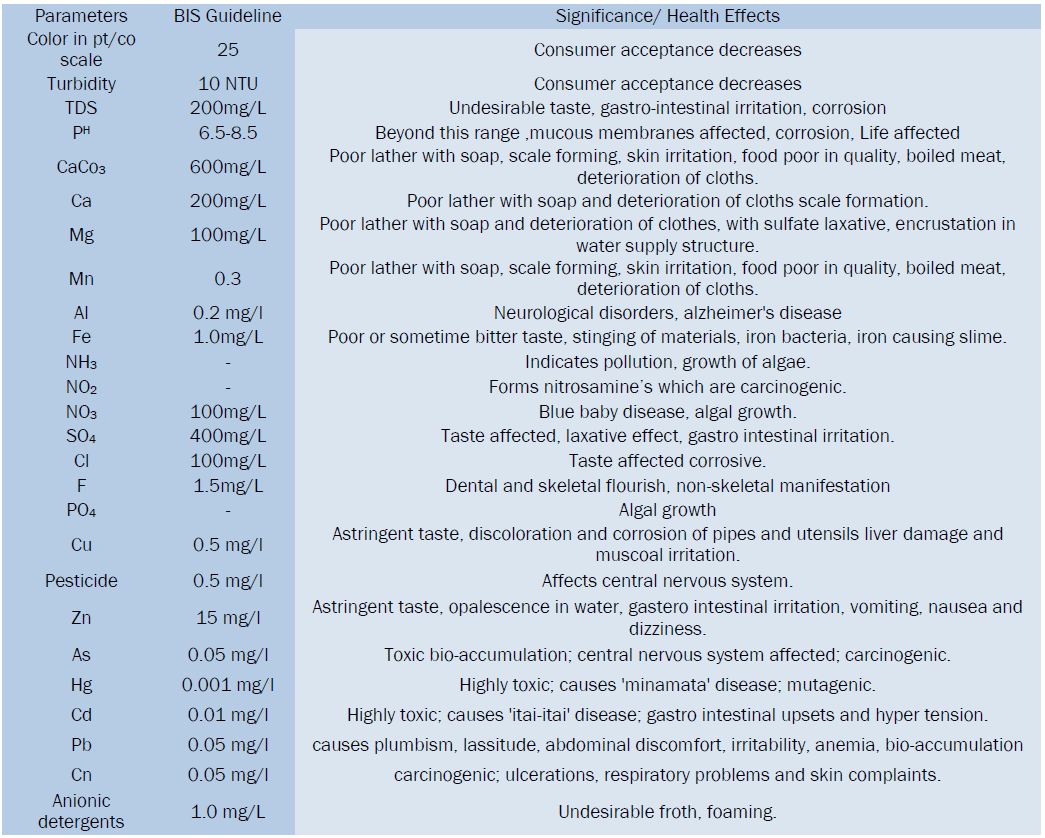
Dindigul is an inland District of Tamilnadu. It lies between 10.3 and 10.48 of North latitude 77.15 and 78.20 of East congitude. The District has extensive hilly and rocky areas with undulating plains covered mostly by red soil North East monsoon benefits Dindigul with a mean annual rainfall of 42.66%. The mean sea level 80.11 M Dindigul a small town near Madurai in the State of Tamil Nadu in South India lies in hard rock terrain gramote/ Ground water in Dindigul area is highly polluted.
Houses, schools and hospitals around the Pillayarpalayamare situated at backside of the St.Joseph’s Hospital at Dindigul. The pillayarpalayam is in the down limit located in the downward area. People living in around the Pillayarpalayam are depending on ground water and well water. Bore well water and well water are the source of Pillayarpalayam in town limit. Water is highly polluted due to sewage and hospital wastage.
During the Monsoon and post monsoon seasons, St.Joseph’s Hospital discharges the hospital and sewage water without any treatment in to the Pillaiyarpalayam area. Many houses are also continuously discharging waste water in to the street. The polluted water seeps in to the ground water. Due to percolation the quality of ground water in and around the Pillaiyarpalayam is affected very much. The ground water is highly saline and unfit for drinking purpose. But the people have to depend on the ground water only. On seeing the sufferings of the people around the Pillaiyarpalayam, Sincere and serious attempt were made to find the ground water quality and also suggest a suitable remedy for a water treatment.
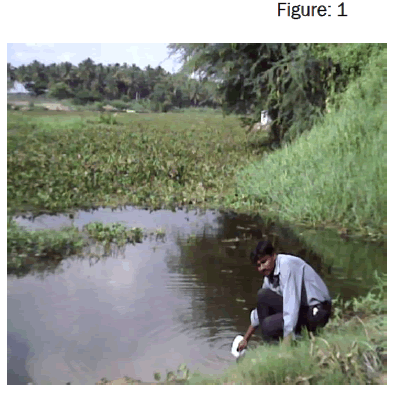
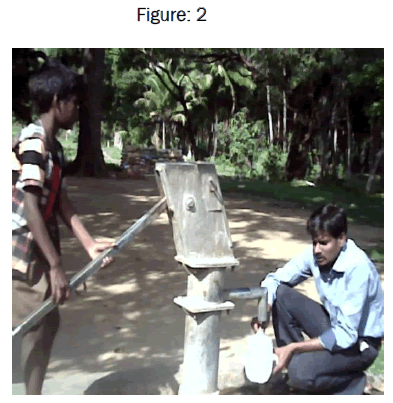
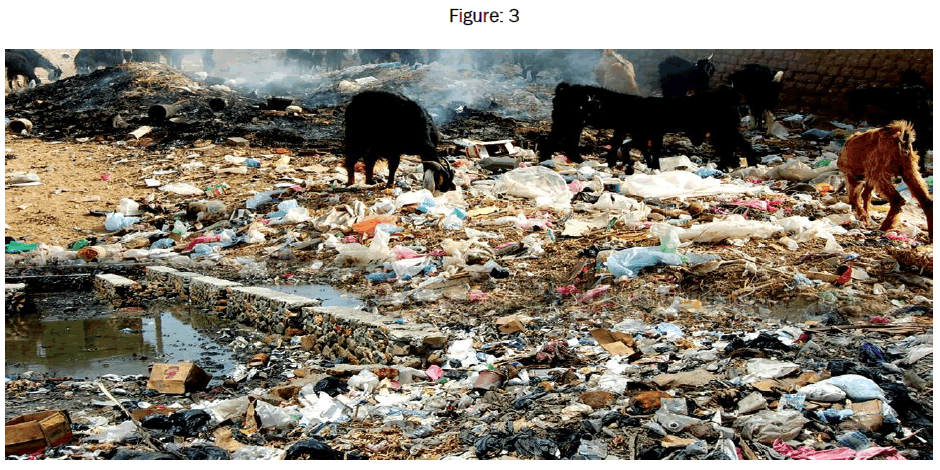
The physical and chemical parameter analysis of ground water and Maruthanikulam pond are presented and discussed.
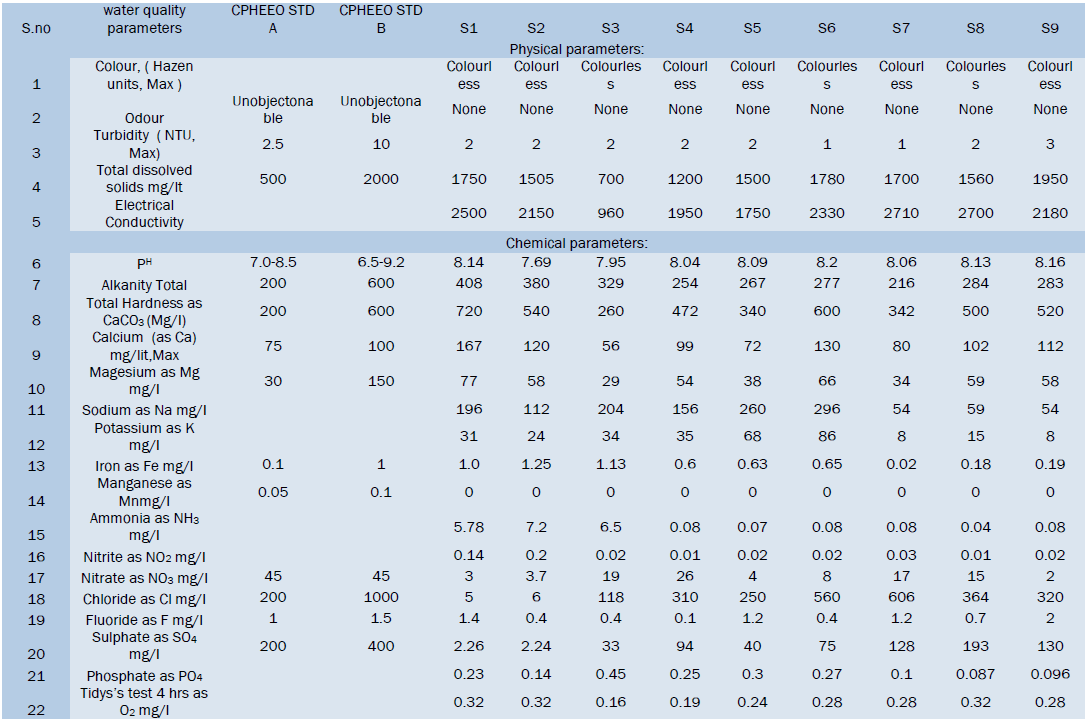
CPHEEO: Central Public Health Engineering and Environmental Organization
CPHEEO STD A – Acceptable limit, CPHEEO STD B – Cause for Rejection
The result of water samples for the several of physico-chemical analyses various sites in the pillaiyarpalayam are presented. The variation in the various physico-chemical characteristics of ground water quality by the seepage of the effluents from the hospital and sewage gives the overall picture of means and standard deviations of the physico-chemical parameters of all the samples are given in the table.
TDS, Hardness, Calcium, Magnesium, Chloride and PH are taken as sensitive parameters to indicate the water pollution by hospital waste water and sewage from various sources.
The PH remained mostly alkaline in the pre monsoon season study. The PH of the ground water varies from minimum 7.69 to maximum 8.16 physical and chemical changes in water are dependent on PH variations of the water. PH shows the suitability of water for drinking and irrigation purpose. In nature PH changes according the seasons. And it’s an index a water quality in ground water. It was observed that the PH of water was fond a higher a pond and low a bore wells. The water PH decrease slightly with increasing distances from pond water. As per the standards of ground water quality for pot ability all the water was within the permissible limits prescribed by BIS standards. The values of PH ranges from 7 to 8.5 are the safe range for drinking as well as growth of plants.
Electrical conductivity of water varies from maximum of 2700 micro mhos/cm to minimum of 380 micro mhos/cm electrical conductivity is an important parameter to find out the dissolved electrolyte is water. The higher value was recorded at well water and low at site 2. Conductivity indicates the presence of dissolved solids so that the conductivity of well water is high. High values of dissolved solids found near the source of sewage. The results correlated with the findings of Cheery and Mcfariane yet al.
A total dissolved solid varies from minimum 673 mg/L to maximum 1974 mg/L. The higher level was recorded at pond shows the water level should be low.
All water samples showed higher TDS value. The total dissolved solid in ground water include all the dissolved solids. In the present study the total dissolved solids ranges from 673 mg/L to 1974 mg/L during pre-monsoon season.
The higher values may be due to low water level and various kinds of polluted ions present in the water. The desirable limits of TDS in drinking water are 500mg/L. The values are exceeds the prescribed limit as per BIS. The values recorded by Dheenadhayalan M.S (1996) were almost higher than the prescribed limit.
Turbidity of ground water varies from minimum 1 NTU to maximum 3 NTU. The presence of finely suspended matter observed only in small amount. Hence it shows Lower value of TDS. The presence of suspended matter may be due to the discharge of solid wastewater in the areas at pond water. Turbidity of the ground water ranges from 1 to 3 NTU units during analysis. The desirable limit prescribed by BIS (1991) is 5 NTU. All the samples show below the prescribed limit. It shows the water from all sites is acceptable for drinking purpose.
The study of Raj Kauretal (2003) shows maximum turbidity 2 to 35.7 NTU during premonsoon particularly the industrial discharge increases turbidity 100 to110 NTU.
The concentration of Chloride level varies from minimum 118 mg/L site 3 to maximum of 606 mg/L at site 8 was recorded during the period of study. The chloride levels are found in variable amounts in water. The chloride content ranges 118 mg/l to 606 mg/l. According to BIS 1991 the highest desirable limits of chloride concentration is specified as 250 mg/l for drinking water. Chlorides values are compared with BIS limit and found that chloride impart bad tastes to water. The increase of chloride ions 420 mg/l to 703 mg/l. Rahman has indicated that the discharging of sewage water and hospital wastage had polluted ground water quality. Analysis reveals that the chloride level is higher than the ISI limit.
Calcium content was found to be maximumof 160 mg/l at site 3 and minimum of 56 mg/l during the period of study. Calcium is one of the most abundant substances innature water Ragothaman. Clearly states that increase of Calcium and contributes to hardness in water and thereby reducing the utility of water for domestic use. The domestic and industrial wastewater contains high amount of inorganic and organic pollutants and the present of calcium observed maximum in premon soon period. In the presents study the calcium ranges from 300 mg/l to 404mt/l which exceeds the acceptable limit of 75 mg/l prescribed by BIS 1991. The increase in Calcium is high due to continuous discharges of wastewater in to the water resources.
The wastewater percolates into the groundwater and affects the water and soil quality according to MS Dheenadhayalan.
Magnesium content varied from 29 mg/l at site 3 to 77 mg/l at site 1. Values of magnesium level concentration were within the prescribed limit. Magnesium is also found in all kinds of natural water along with calcium but its concentration remains generally lower than the concentration of Calcium. In the present study the Magnesium concentration varies from 19 mg/l to 122 mg/l. It is values are 12-49 mg/l in well by Babar et al.
Iron content of water ranges from 0 mg/l to 0.18 mg/l. Low range was found at all bore wells. All the bore well water has higher prescribed iron content as compared to BIS level. Thus the water is used for domestic purpose.
Nitrate in water samples varies from 2 mg/l. The lower level observed at site 9 and the higher level observed at site 4.
The concentration of sulphate was observed maximum at site 1 and minimum at site 3. Sulphate contributes to the hardness of the water along with Calcium and Magnesium. The Sulphate concentration varies from 33 mg/l to 226 mg/l. The concentration of sulphate prescribed as per BIS 1991 is 250 mg/l. The values in all sites are appreciable limit. Thus the water is used for drinking purpose.
Phosphate concentration was observed minimum at site 3, 5, 8 and maximum at site 1.
The concentration of fluoride varies from 0.1 mg/l 1.5 mg/l. The fluoride level are acceptable as prescribed by ISI 1991 is 1.5 mg/l. The presence of fluoride in ground water is more pronounced in the western side of catchments area. The excess of fluoride in water causes dental and skeletal fluorosis and assessment was done by Somashekara Reddy.
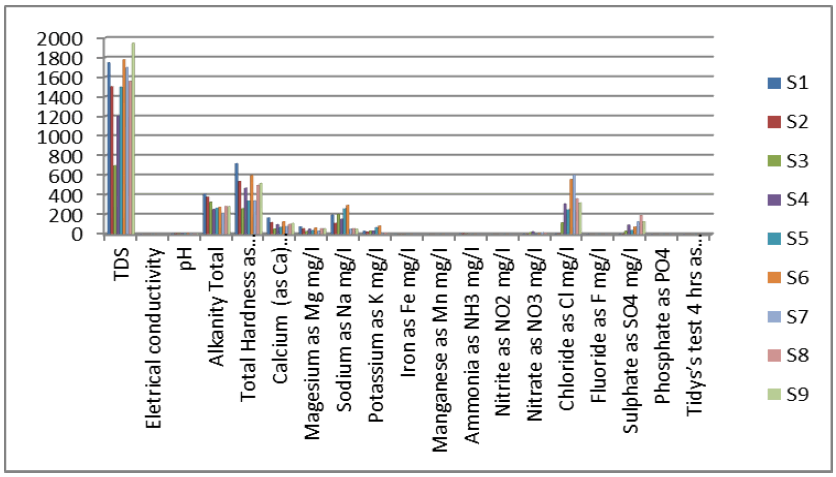
The contamination at Maruthanikulam is insidious. The ground water is highly polluted due to continuous flow of hospital and sewage water from the hospital area. Analysis of physical-chemical characteristic reveals that the pond is polluted to an extremely dangerous level beyond redemption. The pond water cannot be reclaimed due to a very high degree of mixing of sewage and hospital waste water. It is observed from present study that Maruthanikulam is naturally favorable for its collection of various waste water during rainy season because of the natural gradient level. The ground water is collected at various sites cannot be used for domestic, drinking and irrigation purpose. People living in and around the area suffer from the water bone disease like diarrhea, cholera and dysentery. Water bone diseases are prevalent in the study area.
Once an aquifer is polluted percolation of the contaminated hospital waste water and sewage water, it’s very difficult for reclamation in the study area. In many areas of sampling sites, the water was found to be high hardness and the areas are totally abandoned mainly due to the impact of sewage and hospital waste water. The hardness, high TDS, high content of chloride causes the water to be saline. It was also observed in many causes that heavy contamination of well water and bore wells. Hence people have to wait for the corporation water for drinking purpose. People do not use the ground water in their own house for drinking or domestic use. It is concluded that the domestic sewage and the hospital waste water from the study area should not be discharged in to that pond. They should know the purpose of the pond Pillaiyarpalayam people get rainfall once in a year. People have to depend on the rain water for the rest of the year. For the use of rain water the ancestors formed a big pond. Hence people in the study area should wake up to safe guard the ground water because their life liquid is water. Pollution control board should give suitable recommendation for the treatment of hospital waste combine sewage water.